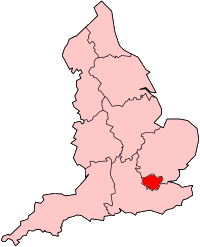History
The first station was opened at the site in 1893 by the Woolwich District Electric Lighting Company adapted from boat repair shops, [1] and subsequently taken over by the Metropolitan Borough of Woolwich. During later construction work in 1912 the timbers of a Tudor warship believed to be Henry VII's 1488 ship Sovereign were uncovered on the site. [2]
The station was redeveloped in the 1920s and again in the 1940s and 1950s, ultimately having three fluted brick chimneys on the east side of the station. It occupied a site of just over seven and a half acres.
In 1906 alternating current and direct current was being supplied generated by a 2.5 MW machine supplied by C.A. Parsons Ltd. [3] Between 1912 and 1917 additional plant was installed ranging from 1.5 MW to 6 MW capacity. [3] The generating capacity, maximum load, and electricity generated and sold was as follows: [4]
Woolwich power station generating capacity, load and electricity produced and sold, 1903–36| Year | Generating capacity, MW | Maximum load, MW | Electricity generated, GWh | Electricity sold, GWh |
|---|
| 1903/4 | 1.458 | 0.733 | 0.763 | 0.695 |
| 1912/3 | 1.750 | 1.610 | 3.504 | 2.939 |
| 1918/9 | 12.51 | 8.615 | 28.142 | 25.416 |
| 1919/20 | 12.51 | 6.979 | 14.574 | 12.537 |
| 1923/4 | 20.25 | 10.550 | 29.107 | 23.600 |
| 1936/7 | 40.00 | 40.74 | 90.261 (134.0 purchased) | 125.024 |
The coal used by the station was usually shipped from the Yorkshire and Northumberland areas and offloaded by crane onto a deep trough conveyor. At its peak the station was burning over 1000 tons of coal a day. [5]
Redevelopment
The earliest buildings on the site were replaced in 1924–28. The 1924–28 station known as the low-pressure section had four Babcock & Wilcox boilers (decommissioned 1963) and 1 × 12.5 MW Fraser & Chalmers/GEC turbo-alternator which generated at 6.6 kV. [3] The 1940–48 intermediate-pressure section had six Babcock & Wilcox boilers and 3 × 34.5 MW Fraser & Chalmers/GEC turbo-alternators generating at 22 kV. The final 1952–57 high-pressure section had four John Thompson ‘La Mont’ boilers and 2 × 30 MW Fraser & Chalmers/GEC turbo-alternators generating at 22 kV. [3]
The steam conditions at the turbine stop-valves of the various steam systems were: [6]
Operating conditions of steam systems | Pressure | Temperature |
|---|
| Low pressure | 190 psi (13 bar) | 316 °C |
|---|
| Intermediate pressure | 400 psi (27.6 bar) | 427 °C |
|---|
| High pressure | 600 psi (41.4 bar) | 454 °C |
|---|
The total steam generating capacity from 1966 to 1974 was 1,710,000 lb/hr (215.4 kg/s); then 92.0 kg/s during 1975–78. [6]
One of the high-pressure 30 MW machines was decommissioned in 1971. The three intermediate pressure 34.5 MW machines were decommissioned in 1973, together with the intermediate-pressure boilers. The final 30 MW generator was decommissioned in 1978. [6]
The gross generating capability was: [6] [7]
Electricity Generating Capability| Year(s) | 1954/5 | 1955-6 | 1966-70 | 1971-72 | 1973-4 | 1975-78 |
|---|
| Generating capability MW | 140 | 167 | 178.75 | 176.75 | 164.25 | 60.0 |
|---|
Electricity output
Electricity output from Woolwich power station was as follows. [6] [7] [8] [9]
Woolwich power station annual electricity output GWh.
Closure
The station closed on 30 October 1978 with a generating capacity of 57 megawatts. [10] One chimney was demolished by hand in 1978, and the remaining two by explosives in 1979. The site of the main power station building then became the Waterfront Leisure Centre car park; part of the coaling jetty remains. Around 2020 the car park was sold to Berkeley homes and it became part of the Royal Arsenal development. Ultimately the whole leisure centre will be relocated to General Gordon square.
This page is based on this
Wikipedia article Text is available under the
CC BY-SA 4.0 license; additional terms may apply.
Images, videos and audio are available under their respective licenses.


